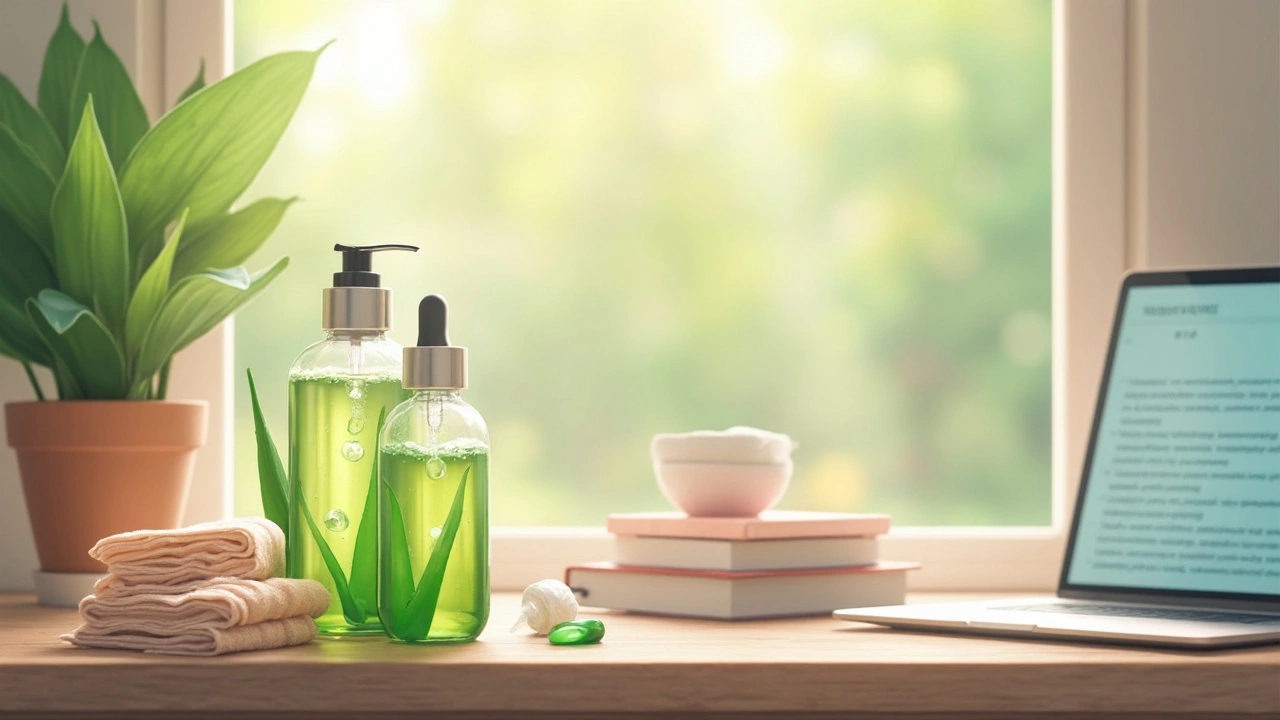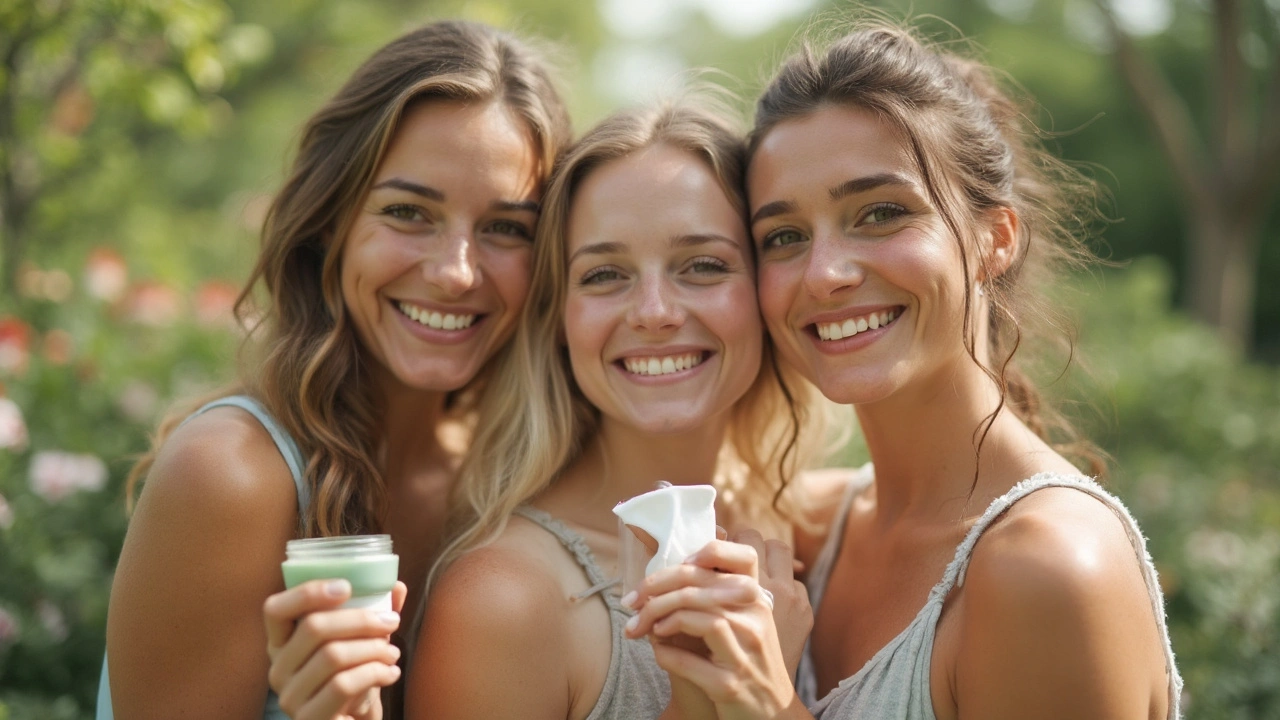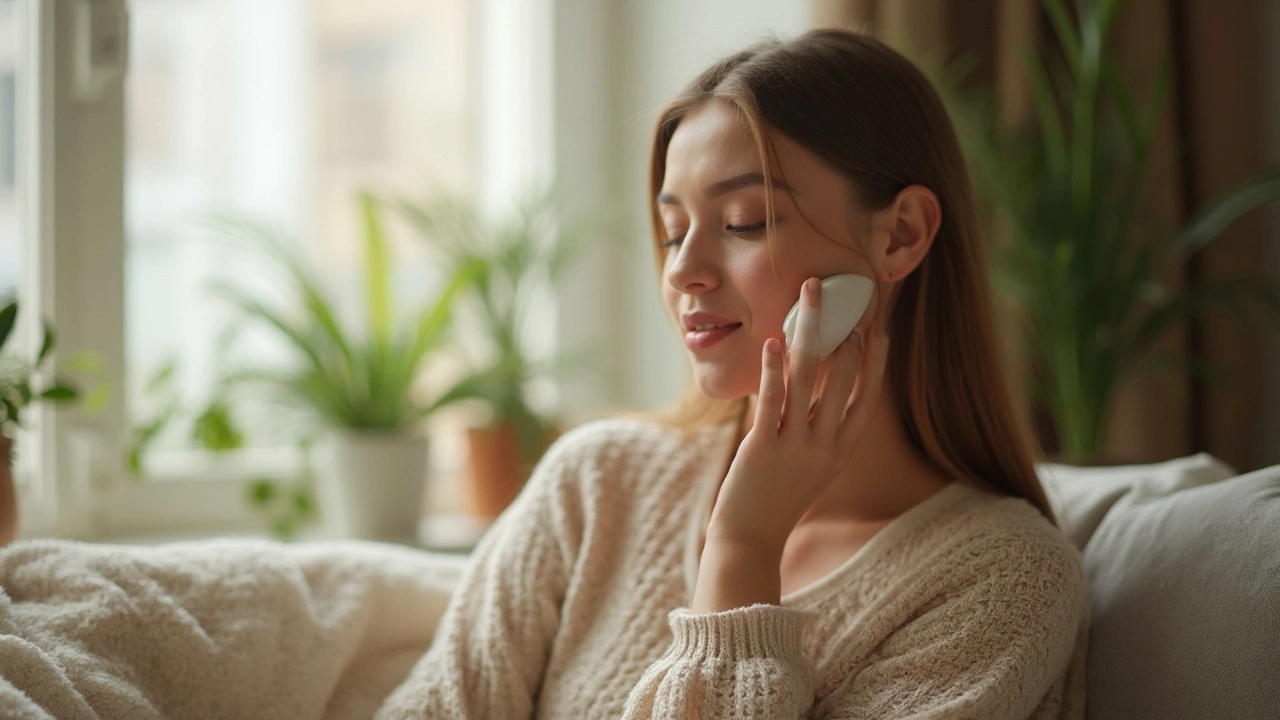If you’ve ever stood in front of the mirror, cheeks flaming, wondering why your sunscreen betrayed you and your rosacea decided to make things ten times worse, you are definitely not alone. Rosacea sunburn isn’t just an uncomfortable combo—it’s like someone turned the heat up just for your skin and then threw in a dash of red just to make sure you wouldn't miss it. The frustrating part? Ordinary fixes for regular sunburns might backfire or crank up the redness even higher for rosacea-prone faces.
The Science Behind Rosacea and Sunburn: Why Your Skin Acts Out
So why does sunlight set off a five-alarm fire on rosacea skin? First, people with rosacea have more sensitive blood vessels just below the surface of their skin. Ultraviolet (UV) rays don’t just burn—they trigger inflammation, cause dilation in these teeny vessels, and leave you looking and feeling miserable. The National Rosacea Society says up to 81% of people with rosacea cite sunlight as their biggest trigger. That’s right: for most, even a brief stroll outside at noon can make cheeks erupt like a stoplight.
Most doctors will tell you the sun won’t just make you red for a day—it can start a flare-up that lasts for weeks. UV rays increase something called reactive oxygen species (think microscopic troublemakers) which mess with your skin barrier. Suddenly, your defenses are down, and anything can irritate your skin. What’s worse, common after-sun solutions like deep-cooling after-sun gels, harsh soaps, or even basic moisturizers can have ingredients that sting, tingle, or cause a rash. Knowing this makes picking the right cooling techniques absolutely critical.
Immediate relief really does help—not just for your comfort, but to keep inflammation in check before things spiral. For serious cases, dermatologists like Dr. Leslie Baumann advise a quick hit of physical cooling (never chemical-laden sprays) followed by ultra-gentle actives that soothe. So, if you’re looking for ways that actually help, let’s talk shop about cold compresses, aloe, and licorice root extract. Each works differently, and it’s not just about slapping something on and hoping for the best.
Cold Compresses: The Fastest Cooling Trick for Rosacea Sunburn
Nobody wants to look like a tomato, so when your face is radiating heat, pulling out a cold compress is the equivalent of an instant ‘chill pill’ for your skin. Here’s why this old-school method outshines anything else for immediate — and safe — relief: it shrinks blood vessels, reduces redness within minutes, and takes down swelling without risking irritation from creams or gels.
Don’t just grab any frozen pack from your freezer, though. Skip harsh materials. Dermatologists suggest filling a soft washcloth with cold water (not ice!) or even using a cool gel mask designed for facial use. Hold it on the affected areas for about 10-15 minutes at a time, then give your skin a break for a few minutes. You can do this several times throughout the day. But here’s a tip: always wrap any very cold object in fabric to avoid shocking those already stressed-out capillaries.
The science checks out. A clinical review from the Journal of Clinical and Aesthetic Dermatology found that rapid cooling directly calms inflammation by blocking the chemical messengers that create the redness storm in rosacea. It’s not just about bringing down the temperature; it’s about fighting off what makes the burn last long after the sun disappears.
Some people swear by rinsing with cold chamomile tea or rose water for an even gentler effect—these both have anti-inflammatory properties. But never go for citrus-infused water or menthol-based cooling pads, as they can punish already sensitive skin. Little adjustments like this really can be the difference between pain and relief when your face is screaming for help.
You’ll know it’s working if the redness starts fading—though don’t expect instant results for deep redness. What you absolutely should avoid: using ice cubes directly, scrubbing or rubbing, or applying frozen veggies (those edges can get sharp!). According to Dr. Jennifer Gordon, “Cold compresses are the safest first-step for calming down a rosacea sunburn as they don’t introduce any new chemicals or potential allergens.”
When your skin needs a reset button, your best bet is the gentle route. Give your face regular cooling sessions, and always follow with a lightweight, non-irritating moisturizer to help preserve the barrier you still have left.

Aloe Vera: Cooling Relief Backed by Centuries—and New Science
The image of someone breaking a leaf off an aloe vera plant and dabbing the cool gel on a burn is pretty much iconic. Aloe really does work for soothing sun-damaged skin—but for faces with rosacea, it comes with a huge asterisk: only pure, fragrance-free aloe is your friend here. Skip the neon-green gel tubs you find at beach shops or drugstores with a list of chemicals longer than your arm.
What makes aloe so powerful? It’s packed with polysaccharides that boost healing, glycoproteins that curb inflammation, and even vitamins C and E for extra cell repair. The American Academy of Dermatology reports that aloe’s pure gel speeds epithelial recovery and soothes both superficial and deeper burns. For rosacea, the anti-redness punch comes from bradykinase, an enzyme that helps stop swelling and redness before it takes over your whole face.
Here’s the trick: apply a thin layer of 98-100% pure aloe vera gel (or straight from a fresh plant if you’re a plant parent) after using a cold compress. Gently smooth it on—don’t rub, as friction is not what rosacea-prone skin needs right now. Let it sit for 10-15 minutes, then either pat off any excess or leave it for ongoing hydration. Don’t reapply more than a couple of times a day, as even pure aloe can sometimes irritate ultra-sensitive skin if overused.
Worried about allergies? Test a tiny dab behind your ear or on your jaw before slathering it all over. Even natural remedies can cause problems if your skin is already close to its limit. “Aloe barbadensis leaf extract has been used for over 2,000 years for burn treatment, but always check labels for fragrance and alcohol, which can negate the benefits,” says Dr. Andrea Suarez (Dr. Dray). Many in-the-know dermatologists keep a bottle of simple aloe gel in their office for emergency use—and it even comes in convenient travel tins for summer trips.
If you want even more cooling, store the aloe gel in the fridge. But don’t freeze it—super-cold aloe gets clumpy and loses its soothing texture. Bonus: you can mix aloe with a drop or two of chamomile oil for an extra anti-inflammatory boost (just avoid essential oils in high concentrations). Patients report that a chilled, pure aloe mask gives fast, dramatic comfort and helps regain that fresh-face feeling faster after a flare.
Licorice Root Extract: Nature’s Secret for Fighting Redness and Calm Rosacea Sunburn
This one surprises a lot of people: licorice root isn’t just for candy or herbal tea. Turns out, it’s possibly nature’s most underrated redness remedy, and new research is actually backing up what traditional medicine has guessed for centuries. The active compound, glabridin, blocks tyrosinase (an enzyme that aggravates pigmentation and redness) while directly interfering with inflammation.
Clinical studies, including a 2023 paper in the Dermatology Practical & Conceptual Journal, confirm licorice root extract can shrink both the intensity and size of red splotches in sensitive skin. It also helps repair the skin barrier, which sunburn and rosacea both love to destroy. That’s what makes licorice root even more effective: it isn’t just fighting current redness, it helps fortify your defenses for the next day you get ambitious and spend too long outside.
You can find licorice root extract (look for Glycyrrhiza glabra on the label) in serums or calming creams. Go for something with 1-3% concentration. Always patch test, since even plant-based extracts can trouble hypersensitive skin. Apply gently after your cold compress and aloe session—either before moisturizer or as a light top layer. Don’t add this step if your skin feels raw or cracked; give it a day or two.
Licorice root isn’t only about instant results, though most people see redness drop after one or two days. “Licorice extract’s anti-inflammatory effects are well-documented, making it an ideal ingredient for those with rosacea-prone skin that is reacting badly to UV exposure,” says Dr. Zoe Diana Draelos, a top dermatologist and researcher. A bonus: licorice can also curb post-inflammatory hyperpigmentation, so if you get those brownish marks after a bad burn, it gives you extra insurance.
If you make DIY recipes, never use raw licorice root meant for tea or food. Skincare extracts are purified to concentrate the good stuff and leave out the irritants. When in doubt, look for products made for facial redness or sensitive skin, and double-check there’s no alcohol, fragrance, or unnecessary preservatives.
By layering these three—cold compresses, aloe, and licorice root—you attack the problem from several directions: reducing heat and swelling, healing damage, and calming down those capillaries without harsh side effects. If you ever want more information on how to calm rosacea sunburn or need fresh product ideas, that site breaks down not only relief but prevention tips worth bookmarking before your next sunny outing.

Smart Aftercare and What to Never Do After a Rosacea Sunburn
Don’t get caught focusing on instant relief and then accidentally sabotaging your skin right after. There are some really common mistakes rosacea-prone folks make that prolong the pain and can drag out healing for ages. First: do not grab a grainy exfoliator or alcohol-based toner. Sun + rosacea + exfoliant equals ouch and extra inflammation. Red, scaly, or peeling skin is best left to heal quietly, no matter how tempting it is to scrub away flakes.
If you must moisturize (and you should), stick with bland, barrier repair creams high in ceramides, glycerin, or niacinamide. These sell for slightly more, but the protection and comfort they offer are worth every penny. Your moisturizer should never tingle or sting—if it does, that’s a sign it contains irritating ingredients or you need a basic formula like plain petrolatum or Cicaplast Baume. During the recovery window, skip all acids (AHA, BHA, vitamin C serums).
Avoid hot water for a few days—yes, even those relaxing hot showers. Heat expands the very blood vessels you’re trying to calm down. Lukewarm water only, and use a gentle cleanser (no foaming agents, fragrance, or fancy anti-aging extras). Pat dry softly, don’t rub, and swap out rough towels for microfiber or ultra-soft washcloths.
Many people forget: you need to go makeup-free for at least 24-48 hours. Even mineral makeup can stop your skin from breathing. If you absolutely have to leave the house, use a non-comedogenic, zinc-rich mineral sunscreen made for sensitive skin, like La Roche-Posay Anthelios Mineral. Don’t reapply with sprays—use gentle cream formulas and dab, not swipe, onto the skin.
Nourish from the inside, too. Hydration and anti-inflammatory foods help your skin repair itself. Try cucumber, watermelon, green tea, and omega-3-rich meals. It’s not just about what’s in your skincare routine—the fastest healing comes from a whole-body, gentle approach.
“Rosacea flares from sunburn need to be taken seriously, as repeated episodes create chronic skin barrier damage. Treat quickly and gently to prevent long-term redness and visible blood vessels.” – Dr. Sheila Farhang, board-certified dermatologist
Here’s a go-to list of what you absolutely should not do after a rosacea sunburn:
- No retinoids or prescription actives until redness is totally gone.
- No facial steams or saunas for the next week.
- No alcohol wipes, astringents, or clay masks during recovery.
- Don’t cover with thick creams containing lanolin or heavy oils—they trap heat.
- Skip waxing, threading, or any hair removal near the burn zone.
Your goal now isn’t just comfort—it’s protecting your skin from developing even more persistent redness or visible capillaries that never go away. Quick, smart moves and gentle ingredients don’t just give you immediate relief—they set you up for stronger, clearer skin next time the sun comes out. And hey, maybe next time, a hat and some extra sunscreen will top the list.

Kelvin Murigi
June 3, 2025 AT 19:32When a rosacea‑prone face meets an unexpected sunburst, the first priority is to halt the inflammatory cascade before it spirals out of control.
Cold compresses are the fastest, chemical‑free method to constrict dilated capillaries and stem the bleed‑through of redness.
Use a soft, clean washcloth soaked in chilled (not icy) water and apply gentle pressure for ten to fifteen minutes, then rest for a few minutes before repeating as needed throughout the day.
Avoid direct ice contact; the extreme cold can shock fragile vessels and paradoxically increase swelling.
After the compress, a thin layer of 98‑100% pure aloe vera gel provides polysaccharides that accelerate epidermal repair while delivering a soothing, cooling sensation.
For maximum efficacy, store the aloe gel in the refrigerator but never freeze it, as crystallisation disrupts the gel’s mucopolysaccharide matrix.
Follow the aloe with a lightweight, fragrance‑free moisturizer rich in ceramides or niacinamide to rebuild the skin barrier without provoking irritation.
When selecting moisturizers, steer clear of products containing alcohol, essential oils, or high concentrations of acids, as these can reignite vascular dilation.
Licorice root extract, standardized to 1‑3% glabridin, is a potent antioxidant that inhibits tyrosinase activity and directly dampens inflammatory mediators, making it an excellent adjunct for diminishing persistent redness.
Apply the licorice serum after the aloe, gently patting it in before sealing with your barrier‑repair cream; this layered approach attacks the problem from three complementary angles.
Patch‑test every new product on a discreet area such as the jawline or behind the ear to ensure no adverse reaction before full‑face application.
Hydration is a systemic ally: drink ample water and incorporate omega‑3‑rich foods like salmon, walnuts, and flaxseed to support cellular recovery from the inside out.
Avoid hot showers, harsh exfoliants, and any form of mechanical friction for at least 48 hours, as heat and shear stress prolong vasodilation.
Steer clear of retinoids, AHAs, and vitamin C serums until the erythema fully subsides; these actives are too aggressive for compromised skin.
Finally, embrace preventive habits: a broad‑spectrum zinc‑oxide sunscreen, wide‑brimmed hat, and shade‑seeking behavior are your first line of defense against future rosacea‑triggering sunburns.
By integrating these evidence‑based steps, you’ll not only achieve rapid relief but also fortify your skin’s resilience for the next sunny adventure.
ahmad matt
June 3, 2025 AT 20:56Honestly you people keep overcomplicating a simple problem you could solve with a plain cold towel and some aloe stop looking for miracle cures and just use what actually works
kristine ayroso
June 3, 2025 AT 22:19I get what you r saying but yeah sometimes a lil bit of extra love w/ a good licorice serum can make a big diff dont forget to test first tho and keep it gentle im all for the practical stuff but also wanna see ppl glow
Ben Small
June 3, 2025 AT 23:42Cold compresses are a game‑changer!
Dylan Hilton
June 4, 2025 AT 01:06Your comprehensive guide is spot‑on, Kelvin. I especially appreciate the emphasis on avoiding fragrances and the step‑by‑step layering method, which keeps the regimen both effective and gentle.
Christian Andrabado
June 4, 2025 AT 02:29Note: "spot‑on" should be hyphenated and "fragrances" is plural; avoid em dashes in casual posts.
Chidi Anslem
June 4, 2025 AT 03:52Beyond the biochemical pathways, consider the skin as a dialog between the body and environment; cooling interventions not only soothe the surface but also signal the nervous system to reduce stress‑induced vasodilation, fostering a holistic equilibrium.